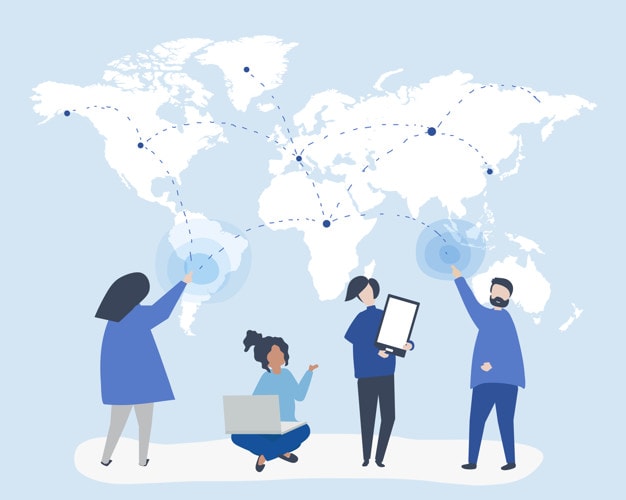What Are the Advantages of Internal Communications Strategy for Organizations?
Effective internal communications are crucial for smooth business operations Discover 5 types of strategies, advantages, and steps to design a successful internal communications system for your organization
Effective internal communication is crucial for the smooth and efficient running of modern businesses. Just as external marketing campaigns are important, so too are internal communication initiatives. A well-established channel for circulating messages within your company structure is essential, as the success of your objectives will depend on it.
Choosing a legitimate channel ensures that the message reaches the most relevant audiences, leading to successful accomplishment of internal communication objectives. This, in turn, enables businesses to operate with greater speed and efficiency.
Let's begin by exploring the realm of internal communications and the crucial role it plays in the effective operation of any business. To start, it's important to define what an internal communications strategy is and how a well-functioning internal communicator system can benefit an organization.
What is Internal Communications?
Effective internal communications involves keeping your staff up-to-date with the latest developments within your organization. By fostering a sense of community and shared purpose, employees are more likely to feel invested in the company and committed to their role beyond just fulfilling their job duties.
Providing timely and relevant information is key to fostering trust between managers and employees, thus facilitating productive collaboration. This approach also promotes high staff morale, as contented employees are more likely to remain in their roles and deliver exceptional work. Effective internal communication strategies may include newsletters, email updates from managers, and notifications about ongoing projects, company events, new hires, and promotions. Such content is particularly valuable for busy employees who may not have the time to read extensive memos throughout the day.
How Optimized Internal Communications work?
All this is designed and channelized in a manner that guarantees each employee engagement about the role they are supposed to play in accomplishing the overall business goals.
The job of Internal Communications in Contemporary Company Cultures
Poorly implemented internal communication strategies can result in employees developing their own methods of communication that often lead to irregularities and inconsistencies within the organization. It is crucial for companies to establish effective internal communication channels to ensure that all employees are on the same page and working towards the same goals. This not only improves overall productivity but also fosters a sense of unity and collaboration among team members.
Poor internal communication strategies can lead to various negative consequences such as low performance, unhappy customers, disengaged employees, and reduced profits. Therefore, it is crucial to recognize that effective communication involves emotional intelligence, as it directly impacts the way employees think and work. Managers and administrators must communicate effectively, using both verbal and non-verbal cues, to ensure a positive outcome.
According to a recent study, the majority of workers, approximately 70%, attribute their decision to leave a company to their manager rather than the job or the company itself. However, poor internal communication can have even more detrimental effects as leaders, managers, and business owners may become confused when different departments within the organization do not share common objectives necessary for achieving overall business goals.
facilitating collaboration, enhancing productivity, and improving employee satisfaction. By effectively communicating with employees, businesses can create a culture of transparency and trust, which can lead to higher engagement levels and ultimately better performance. Investing in internal communication tools and training can also help businesses to streamline processes and reduce inefficiencies, leading to cost savings and increased profitability. Ultimately, prioritizing internal communication can have a significant impact on the success and sustainability of a business.
Letting staffs know what is imperative to the business
Why it’s significant
By executing it successfully, you can help your employees comprehend the correlation between your company's commitments and the important actions taken. Ultimately, these actions will translate into the customer experiences they receive.
1. Leadership and top-down communications strategy
This is the traditional form of internal communications in which message distribution occurs in a top-down manner. In this, information flows from the business to the workforce.
emails, newsletters, company-wide meetings, town halls, and intranet platforms. These communication channels allow senior leaders to share their vision, goals, and updates with employees, while also providing a platform for employees to ask questions and provide feedback. This type of communication fosters transparency and trust between senior leaders and employees, which ultimately leads to a more engaged and productive workforce.
Business strategy overviews
Performance or progress
Company updates
Company-wide accolades, awards, or recognition
Formal announcements
2. Change communication
Communication is vital for the growth of any business, and change is a necessary component of that growth. This is where change communications come into play.
It's essential to communicate any changes internally to your organization to ensure that your staff is aware of them, and you can address any concerns they may have. There are various message distribution strategies that can be used in this process.
Drip feed campaigns
Different messages that are crucial in change communications are –
Structure business change like acquisition, merger
Office openings, closures, moves
Use of new tools
Regulatory and compliance charge
3. Crisis communication
Being prepared with crisis management plans is one of the most integral practices of effective business management.
Crisis communication is an integral part of this form of internal communication.
Different crises that are communicated through this are –
Natural disasters
Technology crisis such as cyber-attack, virus or outage
The leak of private information
Product failings
External threats to the workforce
Organizational misdeeds
4. Information communication
Information is the most important factor through which the workforces need to be fully equipped.
Employee performance data, such as sales figures, project completion rates, and customer satisfaction ratings.
Rewritten:
Information communication encompasses a wide range of factors that impact employee performance, including their efficiency, training, experience, and safety. This involves the use of various types of data, such as sales figures, project completion rates, and customer satisfaction ratings, to measure and evaluate employee performance.
Policies and procedures
Legal information
Compliance information
How-to information
5. Bottom-up or two-way communication
Effective internal communication is not limited to the dissemination of messages from top management to employees. It should also provide a platform for the workforce to express their concerns and ideas to the higher-ups. This two-way communication model fosters a culture of transparency and accountability, which in turn leads to better decision-making and overall organizational success.
improved employee morale, increased productivity, enhanced problem-solving skills, and better decision-making abilities. By enabling bottom-up communication, leaders can create a more inclusive environment where everyone's voice is heard and valued. This can lead to a more engaged and motivated workforce, which ultimately benefits the organization as a whole. Additionally, two-way communication allows leaders to address employee concerns and feedback in a timely and effective manner, fostering a culture of transparency and trust.
Ideation
Employee feedback in requesting their inputs
Questions and answers when staff needs more clarification
Staff surveys
Pulse surveys
Polls or staff votes
Internal communications encompass a wide range of channels within an organization, including peer communications, internal comms, campaign communications, and culture communications. These channels provide numerous benefits to the organization and its employees.
Internal Communications Advantages for Organizations
Still, thinking for what reason is internal communication significant for your organization?
The advantages of a successful internal communication incorporate –
Higher efficiency
Decreased absenteeism
A higher calibre of services and items
Enhanced innovation
Diminished expenses
Studies have consistently shown that companies with strong internal communication programs tend to have higher market premiums and better returns for their investors compared to those with little to no internal communication.
So, as discussed above, internal communications are one of the essential tools for dealing with numerous issues in the work environment.
Creating an effective internal communication framework involves several key components, including the involvement of company leadership, managers, senior executives, and the HR department. By following the steps outlined below, you can establish a successful internal communication process that effectively engages and informs your employees.
You can enhance the strategic vision of your organization by presenting the values, standards, techniques, and practices that are considered desirable. This will have a significant impact on your organization's overall strategic plan.
2. Find out specialized tools
.
There are also digital tools such as email, instant messaging, video conferencing, and social media platforms. It's important to choose the appropriate tool for each communication, taking into consideration factors such as the urgency of the message, the level of formality required, and the preferred communication style of the recipient. By utilizing effective communication methods, you can build strong relationships with your workforce and foster a positive work environment.
Oral communication means such as general meetings, team addresses, division and branch meetings, manager to staff correspondence
Electronic tools such as email, site, and intranet
Training sessions intended for showing special skills, or team-building exercises
3. Match your specialized tools with objectives
It is crucial to determine the tools that align with the company's goals and objectives. One way to achieve this is by using a memo to convey business-related instructions to a specific group of subordinates. On the other hand, a newsletter can be utilized to communicate company achievements to the entire workforce.
4. Set yourself up
In the next step, you need to get prepared to recognize what to share and how to go about it.
To ensure successful internal communication programs, it's crucial to incorporate innovative and engaging strategies that empower all members of the organization. In addition to the design process, effective internal communication systems require specific attributes that should be considered. Let's explore these attributes below.
Characteristics of Internal Communications Strategy
Different key attributes associated with successful internal communication systems are –
1. All around coordinated & well-timed system
Any message from the organization ought to be given to the workforce before they hear it from some outside sources.
2. Make an Unambiguous system
Your internal communication system ought to say everything explicitly- that implies the message should be thorough that can be easily understood.
3. Crisp, engaging and informative messaging
your employee base is crucial for the success of any organization. Therefore, it is imperative that your internal communication system is designed in a way that motivates and engages your employees. This can be achieved by incorporating elements such as recognition, feedback, and opportunities for growth and development. By doing so, you can foster a culture of collaboration and innovation, which can ultimately lead to better business outcomes.
Effective internal communication starts at the top
Making the connections: Using internal communication to turn strategy into action
Two Strategies for Successful Internal Communication Implementation
In order to effectively channel messages within an organization, it is important to understand the process of implementing internal communication systems. There are two powerful strategies that have proven to be successful, and we will explore them below.
Strategy Making for Internal Communication System in an Organization
In order to optimize the effectiveness of your organization's internal communication, it is crucial to have a clear understanding of your goals and the approach your communication software or system will take to achieve them.
Your strategy making should also consider how it will support your business activities.
7 easy steps will help you make in making the right strategies for internal communications, and they are –
1. Tell
In this, you should simply educate and inform your workforce regarding the direction towards where they are supposed to head. This step will be non-debatable or non-negotiable.
2. Sell
The second step revolves around a procedure or technique for envisioning some type of backlash or debate that might require some negotiation and persuasion skills.
The market segment targeted by a specific product or service should be thoroughly explained in this section. The team responsible for this should have a clear understanding of the associated audience segment.
The proper message and tone are crucial factors in creating a successful internal communication strategy within an organization.
6. Media
Communicating and sharing clear guidelines about the media channels that would be the best for different audience segments should also be part of Internal Communication Strategy Making.
Clearly defining success criteria is crucial, and it's important to share them with relevant teams. Effective communication of various metrics such as ROI, hit rates, quality of feedback, and message penetration is also essential.
Channels of Message Distribution in Internal Communications
Different channels that are considered best-suited for effective internal communications are –
1. Electronic Medium
2. Print medium
Leveraging this channel for internal communications provides the opportunity to utilize traditional paper-based mediums such as magazines, brochures, newsletters, postcards, desk drops, desk calendars, desk memos, diaries, and more.
As per your spending plan, you can come up with best-quality print materials for channelizing your messages.
3. Inter-Personal Method
The channel includes a range of face-to-face or one-to-one message distribution strategies. These methods utilize a variety of forums where individuals gather, such as team meetings, site visits, briefings, orientation sessions, and round table discussions. This approach enables direct communication with individuals or groups, allowing for clear and concise messaging. Physical presence of employees is mandatory for effective face-to-face message distribution.
4. Utilizing Workplace and Office Space
Different message distribution mediums of workplaces can also be used in internal employee communications.
Various methods such as notice boards, LCD or plasma screens, window decals, projectors, and other accessories are frequently used for message distribution in internal communications. However, it is crucial to choose the appropriate channel that suits your specific communication needs. Let us delve into the process of selecting the right channel.
How to choose the proper channels?
1. Choosing channel as per the target audience
When it comes to making decisions for your organization, it's important to consider the preferences of your target audience. The way your team accesses information should reflect the options you want to offer your audience.
2. Choosing channel as per accessibility
When it comes to distributing your message, it's important to consider the channels available within your specific niche. You'll want to make the most of the existing channels, but don't be afraid to experiment with new ones as well. A well-rounded approach can help you reach a wider audience and achieve greater success.
3. Choosing channel as per the content
The next thing you need to consider while choosing a channel is the type of content you are using for sharing the information.
The selection of message distribution channels should be based upon the context of your message that you want to share with your workforce.
4. Choosing channels as per time, schedule and need
When deciding on the most appropriate message distribution channels, it is important to consider both timing and necessity. For time-sensitive communications, ensure that the channel chosen can deliver the message quickly. For well-planned meetings, select a channel that aligns with the schedule.
Moreover, it is advisable for professionals to choose communication channels within the organization that cater to their specific needs. Developing an annual plan based on the communication requirements of the organization can also aid in selecting the most suitable channels for each situation.
Finally, you should also be aware of different means that can optimize your internal communication systems. So, let us go through that as well-
How to Optimize Internal Communications System
:
- Conduct regular team meetings to discuss company updates and progress.
- Use digital platforms such as email, messaging apps, and social media to share information.
- Encourage two-way communication by allowing employees to provide feedback and suggestions.
- Provide training and resources to improve communication skills.
- Celebrate successes and recognize employee achievements to boost morale and engagement.
By implementing these strategies, you can create an effective internal communication system that fosters a positive and productive work environment.
Encourage sharing, input, and dialogue
Have managers lead by example
Get employee buy-in
Make Objectives and goals public
Think of your employees as internal customers
Make “Sticky” information accessible
Make the mission and vision clear
Use online tools instead of meetings
Train people in the language of sharing
Tailor how you communicate to employees
Use mobile tools
Reflect your brand
Create Open Dialogue
Make it two-way
Final Thoughts!
Effective internal communication is essential for any business to operate efficiently and achieve its goals. By providing a platform for employees to communicate with each other and with management, businesses can ensure that everyone is on the same page and working towards the same objectives. This helps to avoid confusion, reduce errors, and ultimately drive better results.
Establishing a strong internal communication system is crucial for businesses today, as it ensures that employees receive timely and accurate information. When companies communicate with their employees in an authentic manner, it fosters a sense of value and motivation among them. Hence, businesses should invest an equal amount of time and resources in communicating with their employees as they do in external marketing efforts.
Do you already have a system for communicating with your employees?
Did we miss any of the key ways that you consider essential for boosting internal communications?
NEXT
External Communication
PREV
Types of Communication














